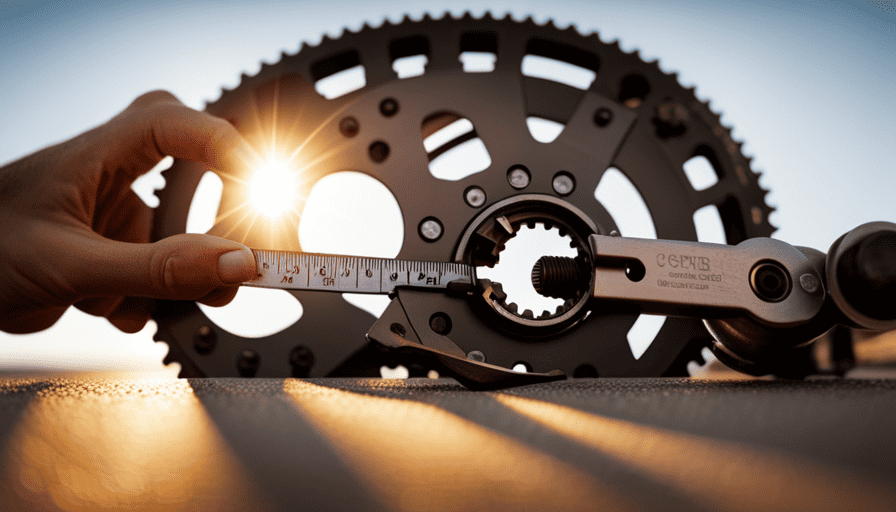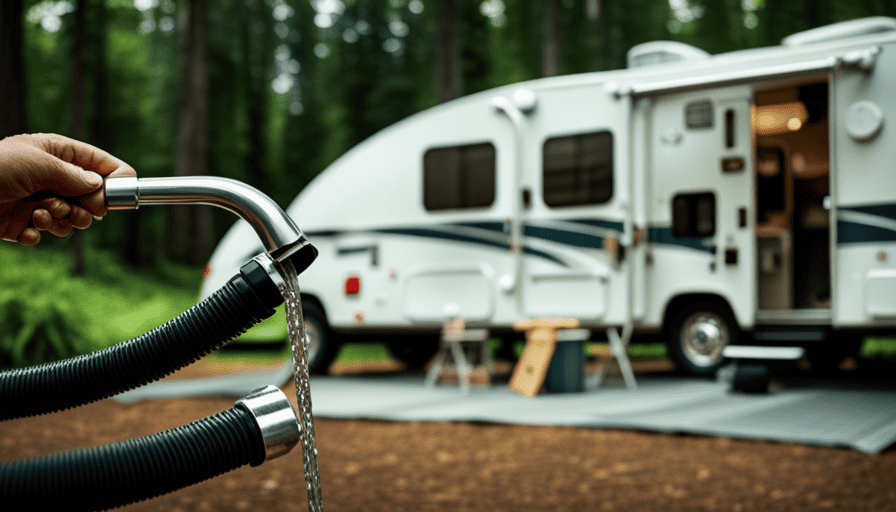When it comes to securing financing for a camper, a crucial decision you’ll have to make is selecting the length of your loan term. The term length of a camper loan can differ based on your financial circumstances and personal preferences.
In this article, I will explore the different loan term options available for camper loans and provide tips for managing loan payments. Whether you’re considering a short-term loan for quick repayment or a long-term loan for lower monthly payments, it’s crucial to choose the right loan term that aligns with your needs.
Additionally, I will discuss the possibility of refinancing your camper loan if you find yourself wanting to adjust the loan duration. By the end of this article, you’ll have a better understanding of how long camper loans can be and how to find the right loan duration for your camper purchase.
Key Takeaways
- Camper loans can range from 3 to 20 years, offering flexibility in loan term duration.
- Shorter loan terms result in quick repayment and savings on interest payments.
- Longer loan terms offer lower monthly payments but may have higher interest costs.
- Factors such as credit history, loan amount, interest rate, and borrower’s income can affect the loan duration.
Overview of Camper Loans
Camper loans can vary in length depending on factors such as the borrower’s credit history, the loan amount, and the lender’s terms and conditions. The duration of a camper loan is an important consideration for borrowers, as it directly impacts the monthly payments and overall cost of the loan.
Several factors can affect the length of a camper loan. Firstly, the borrower’s credit history plays a significant role in determining the loan term options. Those with a strong credit history may have more flexibility in choosing the duration of their loan, as they’re considered less of a risk by lenders. On the other hand, borrowers with a poor credit history may have limited options and may be required to accept a shorter loan term.
Additionally, the loan amount can influence the length of the loan. Higher loan amounts may necessitate longer loan terms to make the monthly payments more affordable. Conversely, smaller loan amounts may be repaid over a shorter period.
Lastly, the lender’s terms and conditions also impact the loan duration. Each lender may offer different loan term options, ranging from a few years to several decades.
Considering these factors, borrowers should carefully review their credit history, loan amount, and lender’s terms and conditions to determine the most suitable loan duration for their camper loan. Transitioning into the subsequent section about ‘loan term options,’ it’s essential to explore the various options available to borrowers.
Loan Term Options
The duration of camper loans can vary depending on the chosen loan term options. When it comes to loan repayment, borrowers have the flexibility to select a loan duration that suits their financial situation.
Typically, camper loans can range from 3 to 20 years. Shorter loan terms, such as 3 to 5 years, may be ideal for those who want to pay off the loan quickly and save on interest payments. On the other hand, longer loan terms, such as 10 to 20 years, offer lower monthly payments but may result in higher interest costs over time.
It’s essential for borrowers to carefully consider their financial goals and capabilities when choosing a loan term. By evaluating their budget and long-term plans, borrowers can determine the loan duration that best fits their needs.
Now, let’s move on to the next section, where we will discuss short-term loans and their benefits.
Short-term Loans
If you’re looking for a quicker way to pay off your loan and save on interest, consider opting for a shorter loan term option. Short-term loans typically have a repayment period of less than five years, making them a popular choice for those who want to own their camper sooner rather than later.
Here are some key requirements to keep in mind when considering a short-term loan:
-
Higher monthly payments: Since the loan term is shorter, you can expect higher monthly payments compared to longer loan terms. This means you need to ensure that your budget can accommodate these higher payments.
-
Lower interest rates: Short-term loans often come with lower interest rates compared to longer loan terms. This can save you significantly on interest payments over the life of the loan.
-
Faster equity buildup: With shorter loan terms, you build equity in your camper at a faster pace. This can be advantageous if you plan to sell or trade-in your camper in the near future.
Opting for a short-term loan can be a smart financial move if you can afford the higher monthly payments and want to save on interest. However, if you need more flexibility in your budget, medium-term loans may be a better option.
Medium-term Loans
Consider opting for a medium-term loan if you want a balance between manageable monthly payments and a reasonable repayment period. Did you know that medium-term loans have become increasingly popular, with a 20% rise in applications over the past year?
Many people are attracted to medium-term loans because of their favorable interest rates. Compared to short-term loans, medium-term loans generally have lower interest rates, making them more affordable in the long run. This is especially beneficial for those who need to borrow a larger amount of money.
The advantages of medium-term loans extend beyond just lower interest rates. With a medium-term loan, you can spread out your repayments over a longer period of time, typically ranging from two to five years. This allows you to have smaller, more manageable monthly payments. Medium-term loans are also a good option if you have a stable income and are confident in your ability to make regular repayments.
Now that we’ve discussed medium-term loans, let’s move on to long-term loans, which offer even longer repayment periods and lower monthly payments.
Long-term Loans
Looking to finance your dream home? Opt for a long-term loan and enjoy lower monthly payments while still having enough time to comfortably repay the loan.
Long-term loans are typically repaid over a period of 20 to 30 years, making them an attractive option for borrowers who want to spread out their payments over a longer period of time. Here are some key benefits of long-term loans:
-
Lower Monthly Payments: With a longer loan term, the monthly payments are spread out over a longer period, resulting in lower monthly payments compared to shorter-term loans.
-
Increased Affordability: The lower monthly payments make it easier for borrowers to afford a higher loan amount, allowing them to purchase a more expensive camper or RV.
-
Flexibility: Long-term loans provide borrowers with more flexibility in their budget, as the lower monthly payments free up funds for other expenses or investments.
-
Loan Interest: Although long-term loans may have lower monthly payments, it’s important to consider the impact of interest over the life of the loan. Interest accumulates over time, resulting in a higher total repayment amount.
Factors affecting loan duration, such as interest rates and the borrower’s creditworthiness, play a crucial role in determining the overall duration of a camper loan.
Factors Affecting Loan Duration
When it comes to financing your dream home, there are several factors that can affect how long you’ll be repaying your loan. The duration of a camper loan can vary depending on various factors. These factors include the borrower’s credit history, the loan amount, the interest rate, and the borrower’s income.
Credit history plays a significant role in determining the loan duration. Lenders are more likely to offer longer loan terms to borrowers with excellent credit, as they are considered less risky. On the other hand, borrowers with poor credit may be offered shorter loan terms or higher interest rates to compensate for the higher risk.
The loan amount also affects the duration of the loan. Generally, larger loan amounts may have longer repayment periods as they require more time to pay off. Additionally, the interest rate can impact the loan duration. Higher interest rates can result in longer repayment periods to accommodate the higher monthly payments.
To manage loan payments effectively, it is essential to create a budget and stick to it. Allocating a specific portion of your income towards loan payments can help you stay on track and ensure timely repayment. Additionally, considering refinancing options or making extra payments can help shorten the loan duration.
In the next section, we will explore how the loan amount affects the overall financing process.
Loan Amount
Factors affecting loan duration include the loan amount and repayment period. Let’s dive deeper into the impact of the loan amount on the length of a camper loan.
The loan amount refers to the total sum of money borrowed to purchase a camper. Loan amount flexibility is important, as it allows you to choose an amount that suits your financial situation.
Generally, if you borrow a larger amount, the repayment period may be longer. This allows you to spread out the payments over a more extended period, making them more manageable. On the other hand, if you borrow a smaller amount, the repayment period may be shorter. This means you can pay off the loan more quickly and potentially save on interest charges.
It is essential to strike a balance between the loan amount and the repayment period. While a longer repayment period may reduce monthly payments, it can also result in higher interest charges over time.
Now, let’s explore how the interest rate impacts camper loans.
Interest Rate
The interest rate can greatly impact the affordability and overall cost of financing a dream adventure on wheels. When it comes to camper loans, the interest rate is determined by various factors, including the borrower’s credit score and the loan duration.
A higher interest rate can result in higher monthly payments and a longer loan term, which means that you’ll end up paying more in interest over the life of the loan. It’s important to shop around and compare interest rates from different lenders to ensure you’re getting the best deal possible. Even a small difference in interest rates can add up to significant savings over time.
Additionally, it’s worth considering whether a fixed or variable interest rate is right for you. A fixed interest rate remains the same throughout the loan term, providing stability and predictability in your monthly payments. On the other hand, a variable interest rate can fluctuate over time, potentially resulting in lower or higher payments depending on market conditions.
In the next section, we’ll explore how a borrower’s credit score can impact their ability to secure a favorable interest rate.
Borrower’s Credit Score
Securing a dream adventure on wheels is like embarking on a thrilling journey, and your credit score acts as the compass that either steers you towards a favorable interest rate or leaves you stranded in financial uncertainty. Your credit score plays a crucial role in the camper loan approval process. Lenders use it to assess your creditworthiness and determine the risk involved in lending to you. A higher credit score indicates a responsible borrower who is more likely to make timely payments, resulting in a lower interest rate. On the other hand, a lower credit score suggests a higher risk, leading to a higher interest rate or even loan denial.
To understand how your credit score impacts your camper loan, take a look at the table below:
| Credit Score Range | Interest Rate |
|---|---|
| 800-850 | 3.5% |
| 700-799 | 4.2% |
| 600-699 | 6.8% |
| 500-599 | 9.5% |
| Below 500 | 12.0% |
As you can see, a higher credit score can save you thousands of dollars in interest over the life of the loan. It’s essential to maintain a good credit score by paying your bills on time, keeping your credit utilization low, and avoiding excessive debt.
Understanding the impact of your credit score on camper loans sets the stage for exploring the benefits and drawbacks of short-term loans. These loans offer unique advantages and disadvantages that are worth considering before making a decision.
Benefits and Drawbacks of Short-term Loans
Imagine embarking on a thrilling journey with a short-term loan, where you can enjoy the benefits of quick approval and flexibility, but also face the drawbacks of higher interest rates and potentially challenging repayment terms.
Short-term loans offer a variety of advantages and disadvantages that borrowers should consider before making a decision.
Here are four key benefits and drawbacks of short-term loans:
-
Pros: Quick approval process – Short-term loans often have a faster application and approval process compared to long-term loans. This means you can access the funds you need more quickly, which can be crucial in certain situations.
-
Pros: Flexibility – Short-term loans typically have more flexible repayment terms. This allows borrowers to customize their loan to fit their specific financial needs and goals.
-
Cons: Higher interest rates – One of the main drawbacks of short-term loans is that they often come with higher interest rates compared to long-term loans. This can result in higher monthly payments and potentially more overall interest paid.
-
Cons: Potentially challenging repayment terms – The shorter repayment period of short-term loans can make it more difficult for borrowers to meet their repayment obligations. It’s important to carefully assess your financial situation before committing to a short-term loan.
As we move into the discussion on the benefits and drawbacks of medium-term loans, it is essential to consider the various options available and their potential impact on your financial journey.
Benefits and Drawbacks of Medium-term Loans
Embarking on a journey with a medium-term loan is like cruising down a winding road with a reliable car, offering you the advantages of manageable monthly payments and a reasonable repayment period.
Medium-term loans typically have a repayment period of three to seven years, which allows you to spread out your payments and avoid the financial strain of shorter-term loans. With a longer repayment period, you can enjoy a lower monthly payment, giving you more flexibility in your budget. Additionally, medium-term loans often have lower interest rates compared to short-term loans, saving you money in the long run.
However, it’s important to consider the drawbacks of medium-term loans as well. While the longer repayment period may provide you with more breathing room, it also means that you’ll be paying interest for a longer period of time. This can result in higher overall interest costs compared to shorter-term loans. Additionally, since medium-term loans are spread out over several years, you may end up paying more in interest over the life of the loan.
Transitioning into the subsequent section about the benefits and drawbacks of long-term loans, it’s important to weigh the pros and cons of each loan option to make an informed decision that best suits your financial situation.
Benefits and Drawbacks of Long-term Loans
One key consideration when deciding on a loan is weighing the advantages and disadvantages of opting for a longer repayment period. Long-term financing, typically lasting more than five years, comes with its own set of pros and cons.
-
Stability: One of the main benefits of long-term loans is the stability they provide. With fixed monthly payments over an extended period, borrowers can better plan their budgets and have a clear understanding of their financial obligations.
-
Lower monthly payments: Long-term loans often come with lower monthly payments compared to shorter-term options. This can be beneficial for those who’re looking to minimize their monthly expenses and have more cash flow available for other purposes.
-
Higher overall cost: On the downside, the longer the loan term, the more interest you’ll end up paying. This means that even though the monthly payments may be lower, the total cost of the loan will be higher.
Considering the pros and cons of long-term financing, it’s important to carefully evaluate your financial situation and goals when choosing the right loan term. Transitioning to the next section, it’s crucial to analyze factors such as income stability and future plans to determine the most suitable loan duration.
How to Choose the Right Loan Term
To choose the right loan term, you need to get your thinking cap on and consider your financial situation and goals, so you don’t end up in a pickle.
Choosing the loan term for your camper loan is an important decision that will impact your finances for years to come. There are several factors to consider when making this choice.
First, think about your budget and how much you can comfortably afford to pay each month. Longer loan terms may have lower monthly payments, but they also mean paying more interest over time. On the other hand, shorter loan terms may have higher monthly payments, but you’ll pay off the loan sooner and save on interest.
Next, consider the depreciation of the camper. If you plan to keep it for a long time, a longer loan term may be more suitable. However, if you anticipate selling or upgrading within a few years, a shorter loan term could be a better option.
Additionally, think about your future financial goals. If you have other debts or financial priorities, it may be wise to choose a shorter loan term to pay off the camper loan faster and free up funds for other purposes.
Choosing the right loan term for your camper loan requires careful consideration of your budget, the camper’s depreciation, and your future financial goals. By taking these factors into account, you can make an informed decision that aligns with your needs.
Now, let’s explore some tips for managing camper loan payments.
Tips for Managing Camper Loan Payments
If you’re considering financing a recreational vehicle, it’s essential to develop effective strategies for managing your loan payments. Here are some tips to help you effectively manage your camper loan payments:
-
Create a budget: Start by creating a comprehensive budget that includes all your monthly expenses, such as loan payments, insurance, and maintenance costs. This will give you a clear picture of your financial obligations and help you plan accordingly.
-
Set up automatic payments: Consider setting up automatic payments for your camper loan. This will ensure that your payments are made on time, avoiding any late fees or penalties. It’ll also help you stay organized and reduce the risk of forgetting to make a payment.
-
Make extra payments: If possible, try to make extra payments towards your camper loan. This’ll help you pay off the loan faster and save on interest charges in the long run.
Transition: Now that you have some strategies in place for managing your loan payments, let’s explore some refinancing options that can help you save even more money.
Refinancing Options
Consider exploring refinancing options to potentially save more money on your loan payments. Refinancing your camper loan can offer several benefits. One of the main advantages is the opportunity to secure a lower interest rate, which can significantly reduce your monthly payments.
By refinancing, you may also have the option to extend the loan term, giving you more time to pay off the loan and further decrease your monthly expenses.
The refinancing process typically involves applying for a new loan with a different lender to pay off your existing camper loan. It’s important to compare interest rates and loan terms from various lenders to ensure you’re getting the best deal.
Keep in mind that refinancing may come with certain fees or charges, so it’s essential to carefully evaluate the overall cost savings before proceeding.
Refinancing your camper loan can be a smart financial move to lower your monthly payments and potentially save money in the long run. By exploring different refinancing options, you can find a loan with better terms that fit your budget and financial goals.
Next, we’ll discuss finding the right loan duration for your camper purchase.
Conclusion: Finding the Right Loan Duration for Your Camper Purchase
When it comes to financing a camper purchase, refinancing options can provide flexibility and potential savings. However, it is important to consider all factors before making a decision. Now, let’s discuss the conclusion: finding the right loan duration for your camper purchase.
To ensure you find the best interest rate and understand loan terms, it’s crucial to conduct thorough research and comparison. Start by reaching out to multiple lenders and requesting loan quotes. This will allow you to compare interest rates, loan durations, and monthly payments. It’s also important to carefully review the terms and conditions of each loan offer to avoid any surprises down the road.
To help you understand the impact of different loan durations, let’s take a look at the following table:
| Loan Duration | Monthly Payment | Total Interest Paid |
|---|---|---|
| 5 years | $XXX | $XXX |
| 10 years | $XXX | $XXX |
| 15 years | $XXX | $XXX |
| 20 years | $XXX | $XXX |
| 25 years | $XXX | $XXX |
This table highlights how the loan duration affects both the monthly payment and the total interest paid. By carefully considering these factors, you can make an informed decision that aligns with your financial goals and preferences.
Remember, finding the right loan duration is crucial in ensuring a smooth and affordable camper purchase.
Frequently Asked Questions
What are some factors to consider when choosing the right loan term for a camper purchase?
When considering the right loan term for a camper purchase, there are several factors to keep in mind.
One important consideration is repayment flexibility. For example, if you anticipate having extra income in the future, you may want to choose a shorter loan term to pay off the loan faster and save on interest.
On the other hand, if you prefer lower monthly payments, a longer loan term may be more suitable. It ultimately depends on your financial situation and goals.
Can camper loans be refinanced?
Yes, camper loans can be refinanced. Refinancing options allow borrowers to adjust their loan terms, interest rates, and monthly payments.
However, it’s important to consider the potential impact on your credit score before refinancing. If you’re able to secure a lower interest rate or more favorable terms, refinancing can save you money in the long run.
However, it’s essential to carefully evaluate the costs and benefits before making a decision.
What are some tips for managing camper loan payments effectively?
When it comes to managing camper loan payments effectively, there are a few tips and strategies that can help.
First, creating a budget and sticking to it is key. This allows you to allocate funds specifically for your loan payments and avoid unnecessary expenses.
Additionally, paying more than the minimum amount due each month can help you pay off your loan faster and save on interest.
Finally, consider setting up automatic payments to ensure you never miss a payment. These strategies can help you stay on track and manage your camper loan payments effectively.
Is the loan duration for camper loans typically fixed or adjustable?
The loan duration for camper loans can vary depending on whether it’s fixed or adjustable. Fixed-rate camper loans typically have a set loan duration, which means the repayment period remains unchanged throughout the loan term.
On the other hand, adjustable-rate camper loans may have a variable loan duration, as the interest rates can fluctuate over time.
The average loan duration for camper loans can range from 5 to 15 years, depending on various factors such as the loan amount and the borrower’s creditworthiness.
Are there any additional costs or fees associated with camper loans that borrowers should be aware of?
Borrowers should be aware that there may be additional fees or hidden charges associated with camper loans. These costs can vary depending on the lender and the specific loan terms. Examples of additional fees may include origination fees, application fees, and prepayment penalties.
It’s important for borrowers to carefully review the loan agreement and ask the lender about any potential additional costs before finalizing the loan.
Is the Lifespan of Camper Batteries Related to the Length of Camper Loans?
The lifespan of camper batteries is not directly related to the length of camper loans. While camper loans may affect the budget allocated for a battery upgrade or replacement, the actual lifespan of a battery depends on its quality, maintenance, and usage. Regular maintenance and proper charging techniques can significantly impact the longevity of camper battery lifespan.
Conclusion
In conclusion, finding the right loan duration for your camper purchase is crucial to ensure manageable payments and financial stability. It’s important to consider the different loan term options available, such as short-term, medium-term, and long-term loans, and choose the one that fits your financial situation and goals.
One interesting statistic to note is that, according to recent data, the average loan term for camper loans is around 10 to 15 years. This demonstrates the long-term commitment that many people make when purchasing a camper.
By carefully managing your loan payments and considering refinancing options, you can make the most of your camper loan and enjoy your adventures on the road.



















